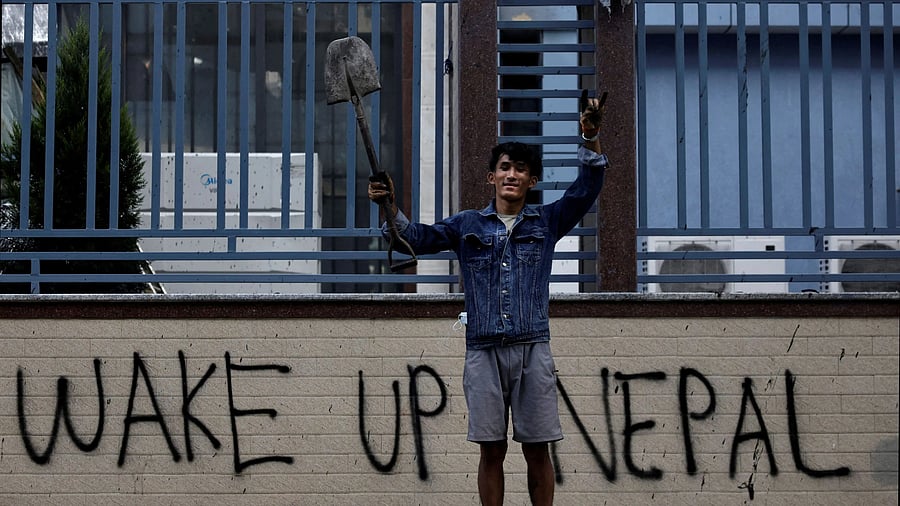
Sabin Tamang, 20, who works in a restaurant and participated in a Gen-Z protest, holds up a shovel while posing for a photograph next to graffiti as he takes part in a cleaning campaign following Monday's deadly anti-corruption protests in Kathmandu.
Credit: Reuters photo
The world’s attention turned to Nepal last week as thousands of young people -- digital natives, dreamers and dissenters collectively termed Gen Z – poured into Kathmandu’s streets in response to a social media ban imposed by the now-gone K P Oli regime. Months of activism on TikTok and #Nepobabies has drawn State ire, resulting in the ban.
Gen Z resisted, taking to the streets to demand their rights. Police brutality that killed 30 young protesters turned peaceful demonstrations into waves of burning, vandalism, and the public humiliation of political family members. The turmoil unsettled Nepal’s political establishment and triggered the dissolution of parliament.
These incidents are a reminder that fragile South Asian democracies remain in transition and that India could play a bigger, more responsible role in regional diplomacy. Nepal’s Gen Z protests demonstrate not only the power of youth but also how experiments in democracy across the neighbourhood stand at critical stages. Community resilience today is deeply political and reflects intergenerational aspirations and hopes.
Across South Asia-- and perhaps in global Asia -- Gen Z is redefining resilience. They are pushing societies to bounce forward, not backwards, despite State repression and setbacks. From Sri Lanka and Bangladesh to Nepal and India’s university campuses, youth protests are demanding justice and rejecting corruption through ‘hashtag’ campaigns on social media.
As we witnessed, Nepal’s youth are not protesting in isolation, but they are part of a generation across South Asia negotiating the weight of history, economic precarity, oppressive regimes, exclusionary policies and digital advocacy possibilities.
Shaped by transition, turmoil
During my teaching years at the Nepal School of Social Work (2004-2012), I saw how Nepal’s Gen Z is global-minded yet deeply rooted in local struggles. Their Instagram stories and YouTube channels today amplify demands as powerfully as their street slogans, reminiscent of the flash mobs of the second Jana Andoloan in 2006. These worldviews are also shaped by global trends and connections with the Nepali diaspora and other youth groups working towards climate justice and LGBTQ rights worldwide.
Nepal’s turbulent 250-year history – from autocratic monarchy and Rana rule to constitutional monarchy and, finally, a federal republic in 2008 -- is etched into collective memory. The scars of the decade-long Maoist insurgency (1996 to 2006), along with repeated disappointments with political elites and the multi-party system, weigh heavily on the nation.
Nepal’s Gen Z, born in the late 1990s and early 2000s, grew up amid civil war, instability, and unfulfilled promises of a “New Nepal”. Now in their late twenties, they are old enough to remember trauma yet young enough to refuse resignation. This dual consciousness -- of historical memory and digital fluency -- makes them distinct. Unlike earlier generations, they are unwilling to wait patiently for reforms. Instead, they are confronting corruption, nepotism, and inequality head-on.
Their critique of “Nepo Kids” flaunting privilege is not envy but a demand for fairness in a republic that promised equality.
To dismiss these protests as mere bursts of youthful anger is to miss their deeper significance. Viewed through the lens of Resilient South Asia, Gen Z mobilisation is not only about regime change but about reimagining society as resilient, aspiring and egalitarian. Resilience here is political, not just technical. Too often, international actors depoliticise resilience, treating it as adaptation or capacity-building. But for Nepal’s youth, resilience means insisting on accountability, resisting corruption, and imagining alternatives. It is not bouncing back to a broken and corrupt political system but bouncing forward towards justice for all.
These protests are about intergenerational justice. Young people are refusing to inherit institutions plagued by impunity. They reject being bound by the burdens of the past and insist that resilience must be participatory. A resilient Nepalese future will not be handed down by elites. It must be co-created with diverse youth voices --from Kathmandu to rural districts, from marginalised communities to migrant returnees whose remittances sustain the economy.
Regional lessons
What can South Asia learn from Nepal’s Gen Z? Three lessons stand out.
1. Youth resilience cannot be dismissed as superficial digital activism. It is rooted in lived histories of conflict, inequality, and transition.
2. Community resilience means confronting, not accommodating, corruption and authoritarianism.
3. Resilient futures require solidarity. Nepal’s protests echo Sri Lanka’s Aragalaya, Bangladesh’s student movements, and Pakistan’s calls for accountability. These struggles may be nationally distinct, but together they signal a generational demand for democratic renewal across the region.
Gen Z’s bravery and hope recall the resilience shown by Nepalese communities during the 2015 Gorkha earthquake. Today, some see hope in the appointment of an interim prime minister backed by sections of Gen Z, but conversations with my former students reveal a generation still restless, imaginative, and confrontational.
For South Asia, the message is clear: Gen Z is not waiting politely for change. They are shaping resilient futures now through social media and street protests, digital advocacy and mobilisation, free expression, community care and solidarity.
(The writer is an associate professor at Thompson Rivers University, Canada, and was earlier with the Nepal School of Social Work, Nepal)
Disclaimer: The views expressed above are the author's own. They do not necessarily reflect the views of DH.